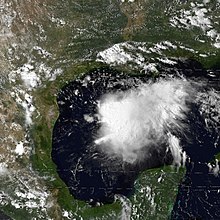Tropical Storm Elena was a weak tropical storm that moved ashore along Texas in the 1979 Atlantic hurricane season. The sixth tropical storm of the season, Elena developed from a tropical wave to the south of Louisiana on August 29. It tracked generally west-northwest, strengthening little before making landfall on Matagorda Island on September 1 as a minimal tropical storm; the storm quickly dissipated over land. Elena dropped moderate rainfall along its path, causing two direct deaths in Houston from drowning; storm damage was minor, amounting to less than $10 million (1979 USD, $28 million 2007 USD). Lightning from the storm set fire to an oil supertanker in Houston, causing three indirect deaths and 13 injuries.
 Tropical Storm Elena near peak intensity south of Louisiana on August 30 | |
| Meteorological history | |
|---|---|
| Formed | August 29, 1979 |
| Dissipated | September 2, 1979 |
| Tropical storm | |
| 1-minute sustained (SSHWS/NWS) | |
| Highest winds | 40 mph (65 km/h) |
| Lowest pressure | 1004 mbar (hPa); 29.65 inHg |
| Overall effects | |
| Fatalities | 2 direct, 3 indirect |
| Injuries | 13+ |
| Damage | $10 million (1979 USD) |
| Areas affected | Texas, Louisiana |
| IBTrACS | |
Part of the 1979 Atlantic hurricane season | |
Meteorological history
editTropical storm (39–73 mph, 63–118 km/h)
Category 1 (74–95 mph, 119–153 km/h)
Category 2 (96–110 mph, 154–177 km/h)
Category 3 (111–129 mph, 178–208 km/h)
Category 4 (130–156 mph, 209–251 km/h)
Category 5 (≥157 mph, ≥252 km/h)
Unknown
A tropical wave moved off the coast of Africa on August 17. It tracked westward, passing through the Lesser Antilles on August 22,[1] and on August 27 the weak wave axis crossed through Florida. A tropical disturbance organized along the wave axis, with ship and buoy reports indicating the development of a low-level circulation by August 29. At 23:08 UTC later that day, a Hurricane Hunters flight reported the existence of a tropical depression;[2] it was classified as Tropical Depression Thirteen,[1] while located about 240 miles (390 km) south of the mouth of the Mississippi River. With a ridge of high pressure located over the southeastern United States, the depression continued tracking generally westward and intensified into Tropical Storm Elena late on August 30.[2] Elena was the sixth tropical storm of the season, as Hurricane Frederic attained tropical storm status six hours prior to Elena.[3]
Unfavorable northerly vertical wind shear persisted through much of Elena's duration, which prohibited the development of convection.[4] An approaching frontal trough weakened the high pressure system to its north, which resulted in Elena turning northwestward toward the Texas coastline. The storm remained poorly organized, failing to strengthen further, and on September 1 it made landfall on Matagorda Island as a minimal tropical storm. The cyclone rapidly weakened after moving ashore, and early on September 2 Elena degenerated into a remnant low pressure area over southeastern Texas.[2] Trapped between two high pressure systems, the remnant mid-level circulation drifted southwestward just inland for several days before dissipating on September 6.[5]
Impact
editAs Elena was upgraded to a tropical storm, the National Hurricane Center issued a gale warning from Port O'Connor, Texas to Morgan City, Louisiana;[4] these remained in effect until the storm moved ashore.[6] Winds were fairly minor in association with the storm; a station in Galveston, Texas recorded a peak wind gust of 46 mph (74 km/h). As Elena moved ashore, it produced a 3-foot (0.91 m) storm tide at Galveston and Baytown.[4] Rainfall from the storm was generally limited to the coastline, and peaked at 10.3 inches (260 mm) at Palacios; light rainfall also extended along the coastline of Louisiana.[5] Near Houston, 4.6 inches (120 mm) of precipitation was reported, which caused two drownings from flooding. Overall storm damage was fairly minor, totaling to less than $10 million (1979 USD, $28 million 2007 USD).[4]
At a dock owned by Shell Oil Company in Deer Park near Houston, a lightning bolt from thunderstorms of Elena struck the oil supertanker SS Chevron Hawaii. The lightning started a fire on the ship, which expanded and wrecked one adjacent barge and burned nearby docks. The ship was nearly split in half from the lightning strike, and oil seeped into Houston Ship Channel for several hours. Firefighters combated the fire on the tanker in boats, but their efforts were hindered due to unsettled weather from Elena, as well as unsafe water to travel through. The fire caused three deaths and 13 injuries, and damage related to the incident totaled $27 million (1979 USD, $76 million 2007 USD).[4][7][8]
See also
editReferences
edit- ^ a b Neil Frank and Gilbert Clark (1980). "Atlantic Tropical Systems of 1979" (PDF). American Meteorological Society. Retrieved 2008-01-04. [dead link]
- ^ a b c National Hurricane Center (1979). "Tropical Storm Elena Preliminary Report". Retrieved 2008-01-04.
- ^ "Atlantic hurricane best track (HURDAT version 2)" (Database). United States National Hurricane Center. May 11, 2024. Retrieved January 12, 2025. This article incorporates text from this source, which is in the public domain.
- Landsea, Chris (April 2022). "The revised Atlantic hurricane database (HURDAT2) - Chris Landsea – April 2022" (PDF). Hurricane Research Division – NOAA/AOML. Miami: Hurricane Research Division – via Atlantic Oceanographic and Meteorological Laboratory.
- ^ a b c d e Paul Hebert (1980). "Atlantic Hurricane Season of 1979" (PDF). American Meteorological Society. Retrieved 2008-01-04. [dead link]
- ^ a b David Roth (2008). "Tropical Storm Elena Rainfall Summary". Hydrometeorological Prediction Center. Retrieved 2008-01-06.
- ^ National Hurricane Center (1979). "Tropical Storm Elena Preliminary Report (Page 2)". Retrieved 2008-01-05.
- ^ United Press International (1979-09-03). "Body Found on Tanker Wreckage". Archived from the original on 2016-01-22. Retrieved 2008-01-04.
- ^ Center for Tankship Excellence. "SS Chevron Oil Accident". Retrieved 2008-03-05.[dead link]